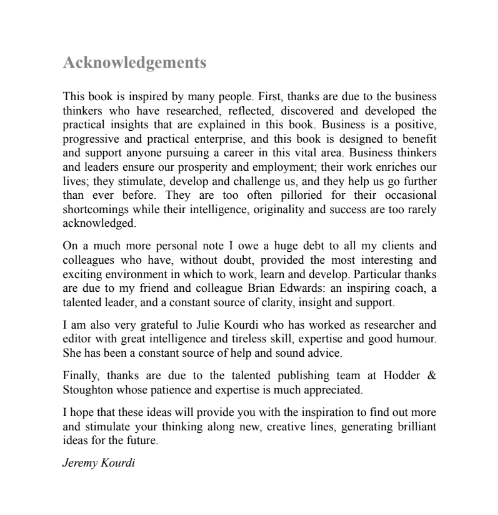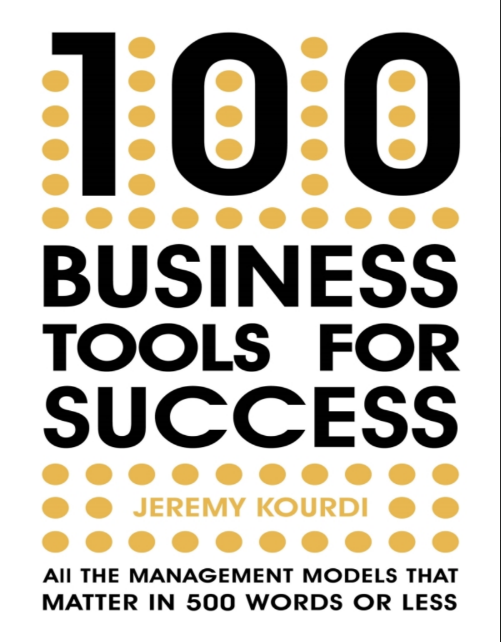


What is the key to success in business for individuals, managers and organizations? Many answers come to mind, notably the ability to serve customers by providing great products or service and creating value, and to do this in way that is efficient, competitive, profitable and valued. Meeting this challenge, however, requires a range of leadership skills, including: the ability to innovate, to learn and develop; to get the best from the people, knowledge and resources around you; and to build business relationships inside and outside the organization. And if all this were not difficult enough, these things need to be achieved constantly, while expectations, opportunities and challenges are constantly shifting. Now, more than ever, is a time of complexity, volatility and change. New ideas, energy and the ability to fit new contexts and meet new challenges are therefore needed constantly to ensure success.
That is why business tools and techniques are so valuable – because they help us meet the many varied challenges faced by business managers and leaders. This is a book about some of the best tools and techniques used in business. What unites these business ideas is their proven power and potency. They are not only insightful and useful but they have worked – and often brilliantly or despite great adversity. The ability of the people who conceived and applied these ideas should be applauded. Interestingly, there are several different themes that run through many of these ideas. These include a willingness to experiment and take a risk, coupled with an ability to understand the root causes of an issue and do something distinctive. Simplicity and an understanding of the need to be practical and implement the idea are also common features of these techniques. Some ideas seem to confirm Peter Drucker’s point that great ideas and decisions are a blend of rigorous analysis and intuition. Finally, the need to be practical, follow through and ensure success is shown by the recurring need to monitor, measure and refine the way the idea works.
There are several specific qualities that characterize the ideas in this book. Keeping these in mind will help you succeed with each technique by applying it successfully to your own context. In particular, the likelihood of success increases if you: • engage people with the technique wherever possible and appropriate • be clear about the specific challenge, issue or opportunity that is being addressed • question and constantly challenge assumptions: yours and others’ • develop a mindset that looks for ways to learn and improve, and are ready to confront challenges and problems early • understand that good ideas can come from anywhere • follow through – be practical and realistic, and plan implementation • give people praise and credit, thereby building momentum • work tirelessly to remove constraints, fears and inhibitions • balance intuition and analysis • build collaboration and teamwork • avoid the pitfalls of decision-making (see technique number 86) • be self-aware and develop your skills. Remember: energy, flexibility, creativity and ingenuity are vital, and there is no room for complacency and little tolerance for inefficiency. I hope that these ideas will help you with your work and stimulate your thinking along new, creative lines, generating brilliant ideas for the future.
All individuals have their own personality – the result both of nature and nurture – and this remains largely unchanging. However, behaviour is different: it is flexible and capable of being developed and enhanced. It’s useful to consider behaviour (yours and others) in terms of warmth or coldness, dominance or submissiveness. *
**Warm** means being supportive, open, positive, empathetic, constructive and engaging – not simply ‘friendly’. * **Cold** means being suspicious, detached, not focused on people or relationships. * **Dominant** means being challenging, in control, confident, strong, authoritative and direct. *
**Submissive** means subduing your own thoughts or actions for something or someone else. The diagram below (the assertiveness model) highlights different types of behaviour (based on the Thomas-Kilmann Conflict Mode Instrument). **Aggressive: dominant and cold behaviour** When dealing with aggressive behaviour, the best approach is to: * increase your dominance to match their high dominance levels * ensure that you are demonstrating behaviour that is assertive and warm rather than aggressive * use open questions to generate understanding * use body language and tone of voice to increase your dominance levels. **Avoiding: cold and submissive behaviour** When dealing with avoiding behaviour, the first priority is to get people engaged. Useful techniques include displaying lower dominance and higher warmth, using open questions aimed at making them feel secure and softening body language and intonation while continuing to smile.
**Appeasing: warm and submissive behaviour** When dealing with appeasing individuals, it can help to: * stay focused to keep them on track * use open questions that appeal to their social needs but temper these with closed questions when they waffle * ask summary questions to maintain clarity and focus * use their name if you are interrupting them. **Assertive: warm and dominant behaviour** When dealing with conflict, it can help to be assertive and encourage others to be assertive as well. Consider how easy it is to warm up behaviour: why and when is it not easy? Why do we, as individuals, not behave in an assertive manner? What is it that hinders supportive and challenging behaviour? Finally, what are the most important questions for you to ask?


